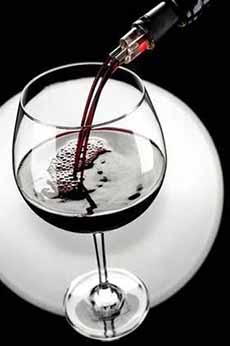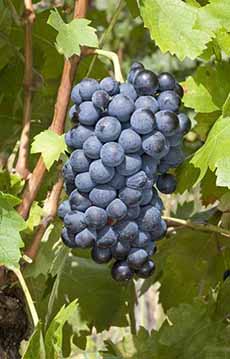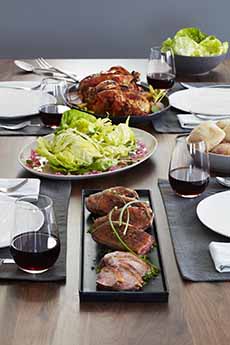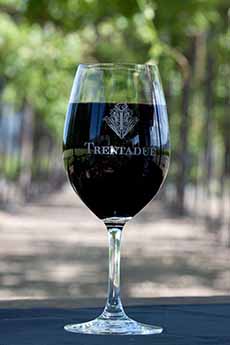It’s National Carignan Day – Do You Know Carignan Red Wine
|
|
October 26th is National Carignan Day. What’s Carignan, you may ask? Carignan (CARE-in-yen), a medium-bodied, medium-tannin red wine from southern France, has long been known as a value wine—i.e., a low-quality wine grape used for bulk wines. The high-yielding grape has long been a major blending grape, adding its fruitiness and color to other wines. But in recent years, Carignan has become known for its ability to make quality wines. A new generation of winemakers is reinvigorating old vineyards and making tremendously rich, red fruit-driven wines. Take a moment to learn about today’s Carignan, a great food wine. If you’re a fan of lighter-style Zinfandels, Merlot, or Côtes du Rhône, then pick up a bottle of Carignan. Ideally, it should be a wine made from old vines (vieilles vignes), where the productivity of the grape clusters is low and the concentration of flavors is high. The wines will burst with fruit and will be smooth on the palate thanks to lighter tannins. > The history of Carignan is below. Outside of widespread planting in the French Midi† (southern France, including Languedoc-Roussillon), Carignan is grown in: Why is Carignan a great food wine? Because of its medium body, it pairs with bold-flavored dishes as well as lighter ones. And the flavor is balanced without bitter tannins. Its fruit-forward, with red fruit and baking spice flavors that pair with the spices in almost any cooked dish. On the palate, with its bold red fruit, pronounced acidity, and earthy-meaty notes, Carignan is an excellent match with: Your wine store clerk can show you what’s available in the store. But for the best American Carignans, here are the winners in the 2023 San Francisco Chronicle Wine Competition: A tip from Wine Folly: Carignan can smell oddly meaty upon first opening a bottle. If yours has a meaty aroma, decant it for at least an hour. The Carignan grape has a long and storied history within the Mediterranean region, particularly in Spain and France. |
|
|
Ampelographers‡ believe that the grape likely originated in Cariñena, Aragon, northern Spain, as the grape is called Cariñena. They believe that Carignan is likely a very old variety due to its widespread plantings and the proliferation of numerous different names that give testament to the grape’s long history in different wine regions [source]. Carignan was introduced to France, specifically the Languedoc-Roussillon region in the southern part of the country, in the 12th century [source]. It reached Sardinia sometime between 1323 and 1720 when the island was under the Spanish influence of the Crown of Aragon [source]. During the late 19th and early 20th centuries, Carignan saw widespread planting in the Languedoc-Roussillon region. It was a prolific vine that produced high yields and was a reliable source of red wine, especially during challenging growing conditions. For much of the 20th century, Carignan was used to produce inexpensive bulk wines. This mass production often resulted in low-quality, diluted wines. Carignan was historically a component of the Rioja red wine blend. The grape’s prominence in France hit a high point in 1988 when it accounted for 167,000 hectares (410,000 acres) and was France’s most widely planted grape variety (used for blending and bulk wines). By the late 20th century, Carignan had gained a reputation for producing wines lacking complexity and finesse. Carignan’s popularity declined, and many vineyards were uprooted or replaced with other grape varieties. In more recent years, there has been a revival of interest in Carignan, particularly in old-vine Carignan vineyards. Winemakers have recognized the potential of old, low-yielding Carignan vines to produce high-quality wines with depth and character. When carefully tended and harvested from older vines, Carignan can yield wines with flavors of dark fruit, spice, and good acidity. Beyond serving as a blending or bulk-wine grape, Carignan is also standing on its own merit, with single varietal bottlings of 100% Carignan. In France, regulations have been put in place to limit the planting of new Carignan vines in an effort to focus on quality over quantity. Old-vine Carignan, especially in the Languedoc region, is highly prized. In the U.S., there’s plenty of Carignan for blending, but with the changing dynamics of the wine industry, the grape is also producing high-quality wines like those mentioned above. Carignan as a fine varietal wine is on a growth trajectory in the U.S. and elsewhere. It can make interesting and distinctive wines, and just as important, it’s hardy and prolific. *Carignan vs. Grenache: Carignan is a medium-body wine while Grenache is medium-full bodied wine. Both are fruit wines but have different flavors. The Carignan flavor profile is known for baking spices, with a hint of licorice and cured meat. The Grenache flavor profile is red fruit—black cherries, raspberries, and strawberries, with hints of cinnamon and anise. †Southern France, also known as the south of France or colloquially in French as le Midi, is a defined geographical area consisting of the regions of France that border the Atlantic Ocean south of the Marais Poitevin, Spain, the Mediterranean Sea, and Italy. ‡Ampelography is the field of botany concerned with the identification and classification of grapevines.
|
||




